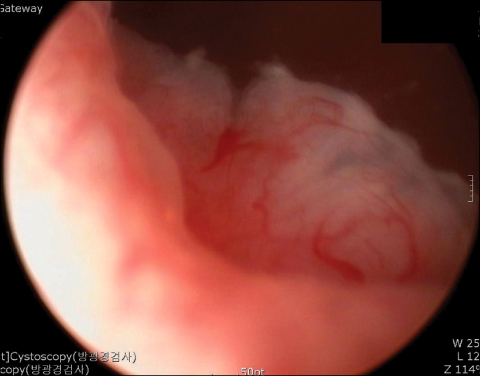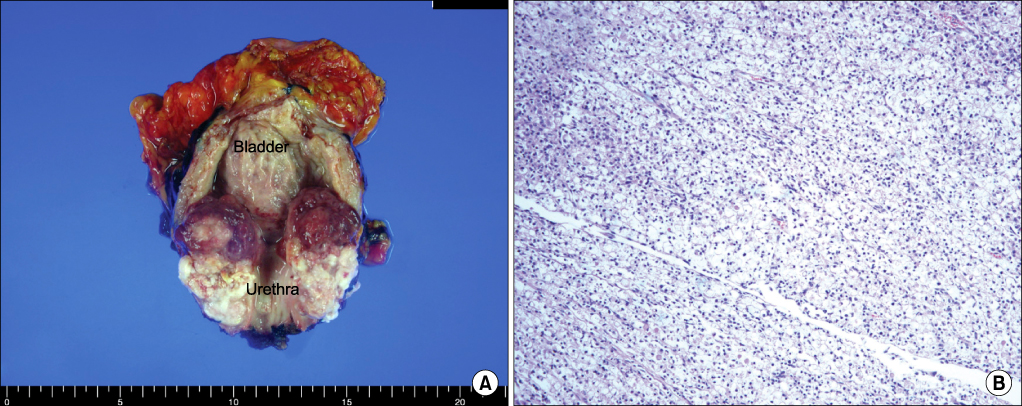Korean J Urol.
2010 Feb;51(2):145-148.
Laparoscopic Radical Cystourethrectomy in a Patient with Adenocarcinoma of the Female Urethral Diverticulum
- Affiliations
-
- 1Department of Urology, Pusan National University Hospital, Pusan National Universtiy School of Medicine, Busan, Korea. hongkooha@pusan.ac.kr
Abstract
- Adenocarcinomas arising in the female urethra have been rarely reported. Here we report a case of laparoscopic radical cystourethrectomy with incontinent urinary diversion in a patient with adenocarcinoma in the urethra and bladder. A 60-year-old female presenting with a history of recurrent cystitis and painless hematuria was referred to our facility with voiding difficulty and a urethral mass. Radiologic evaluation showed an enhanced mass in the urethra and bladder neck. Cystoscopic biopsy of the mass in the bladder neck revealed an adenocarcinoma. Laparoscopic radical cystourethrectomy with anterior vaginal wall excision followed by extracorporeal incontinent urinary diversion was performed.
Keyword
MeSH Terms
Figure
Reference
-
1. Ghoniem G, Khater U, Hairston J, Ramsey A, Woodhouse S. Urinary retention caused by adenocarcinoma arising in recurrent urethral diverticulum. Int Urogynecol J Pelvic Floor Dysfunct. 2004. 15:363–365.2. Davis R, Peterson AC, Lance R. Clear cell adenocarcinoma in a female urethral diverticulum. Urology. 2003. 61:644.3. Hamilton JD, Leach WB. Adenocarcinoma arising in a diverticulum of the female urethra. AMA Arch Pathol. 1951. 51:90–98.4. Takeuchi M, Matsuzaki K, Nishitani H. Clear cell adenocarcinoma of the female urethra: magnetic resonance imaging. J Comput Assist Tomogr. 2009. 33:142–144.5. Park SY, Kim BH, Kim JH, Lee S, Kang GH. Panels of immunohistochemical markers help determine primary sites of metastatic adenocarcinoma. Arch Pathol Lab Med. 2007. 131:1561–1567.6. Choi HG, Son BW, Chung SK, Kim BW. Two cases of primary carcinoma of female urethra. Korean J Urol. 1994. 35:443–447.7. Awakura Y, Nonomura M, Itoh N, Maeno A, Fukuyama T. Adenocarcinoma of the female urethral diverticulum treated by multimodality therapy. Int J Urol. 2003. 10:281–283.8. Cathelineau X, Jaffe J. Laparoscopic radical cystectomy with urinary diversion: what is the optimal technique? Curr Opin Urol. 2007. 17:93–97.9. Abascal Junquera JM, Cecchini Rosell L, Martos Calvo R, Salvador Lacambra C, Celma Domenech A, De Torres I, et al. Presentation of a new case of primary clear cell adenocarcinoma of the urethra and its surgical management. Actas Urol Esp. 2007. 31:411–416.10. Castillo OA, Pinto I, Portalier P, Diaz MA, Vitagliano G. Laparoscopic radical cystoprostatectomy and in block urethrectomy in urethral cancer: initial experience in 2 cases. Surg Laparosc Endosc Percutan Tech. 2007. 17:38–41.




